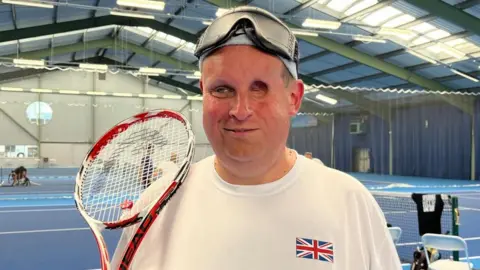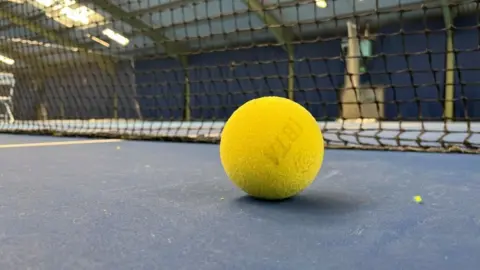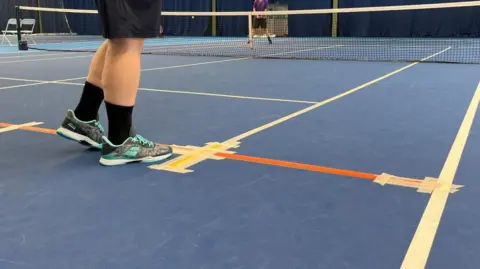'I'm completely blind but I'll play at Wimbledon'
 BBC
BBCFor those unfamiliar with parasports, it might be hard to believe that someone with no eyesight whatsoever would be able to play tennis.
It is a common misconception that Gavin Griffiths encounters.
But for the third year running, the 52-year-old is due to play at Wimbledon in August as part of a national competition for visually impaired competitors.
"You get some people that are totally awestruck by it, other people don't believe a word you're saying. All I can tell them is go look it up on YouTube, said Mr Griffiths, from Nottingham.
His third year at the legendary venue will see him compete in the Vodafone Play Your Way to Wimbledon national finals.
"To know you're walking and playing where people like my heroes Federer, Djokovic, Nadal, Raducanu, other players like that have walked and played... you feel it in the ground," he said.
"It's awe-inspiring for us as visually impaired players to know that we are being taken seriously and that we're given the chance to show our skills."
Mr Griffiths was not born blind. At the age of two he had to have both eyes removed to stop the spread of a rare cancer called retinoblastoma.
He has been "totally blind" since the procedure but the setback has not stopped him from living a fulfilling life.
Previously he played international visually impaired cricket, representing England, as well as football.
"Life wasn't ever going to deal its cards to me. I deal my cards to it, and if it likes to send them back then I'll deal with them that way," he said.
"That was always me and it still is me."
He said he picked up tennis in 2019 because he "fancied a sport where you're on your own", which provided him with a change of pace from the other sports he played.
"Instead of being part of a team and part of a cog in a machine, I wanted a sport that was down to me. If [I make] a bad decision, it's my problem to deal with," he added.
How is tennis adapted?

The LTA, the governing body of tennis in Great Britain, recognises five categories of visual impairment, from B1 (no sight), down to B5 (the most partial sight).
For B1 players such as Mr Griffiths, the court of play is significantly reduced in size, the net is lowered, and the ball is allowed to bounce up to three times.
Meanwhile the ball itself is also altered to make noise when it is hit and when it bounces.
Mr Griffiths said that despite being completely blind, it was standard procedure to play with a blindfold shade regardless, to stop anyone with a degree of light perception from having an advantage.

Looking ahead, Mr Griffiths hopes other people with visual impairments will be inspired to take up tennis as a sport, whether young or old.
He said that anyone who wanted to find out more information about getting involved could visit the LTA website or the British Blind Sport website.
"They'll get you in touch with the nearest [visually impaired] tennis club. There's not loads of them, but if you can it's worth finding the nearest," he said.
"All I can say is come and have a go, because once you've tried it, you won't be able to let go."
Follow BBC Nottingham on Facebook, on X, or on Instagram. Send your story ideas to [email protected] or via WhatsApp on 0808 100 2210.
